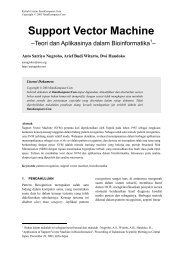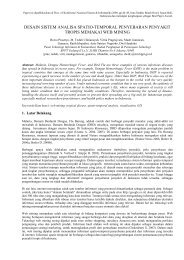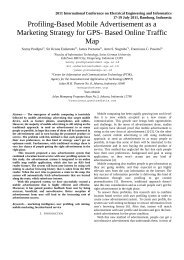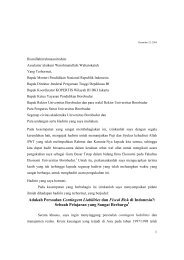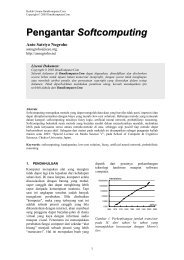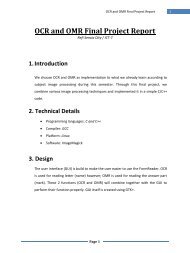Download - Anto Satriyo Nugroho
Download - Anto Satriyo Nugroho
Download - Anto Satriyo Nugroho
Create successful ePaper yourself
Turn your PDF publications into a flip-book with our unique Google optimized e-Paper software.
Published in Proc. of Second International Conference on Advances in Computing, Control, and Telecommunication Technologies - ACT 2010,<br />
pp.198-200, 2 December 2010, Bina Nusantara University, Jakarta, Indonesia<br />
TEXT CLASSIFICATION TECHNIQUES USED<br />
TO FACILITATE CYBER TERRORISM<br />
INVESTIGATION<br />
David Allister Simanjuntak, Heru Purnomo Ipung,<br />
and Charles Lim<br />
Faculty of Information Technology<br />
Swiss German University<br />
EduTown BSDCity, Tangerang, Indonesia 15339<br />
Email: charles.lim@sgu.ac.id<br />
Email: heru.ipung@sgu.ac.id<br />
Email: david.simandjuntak@yahoo.com<br />
Abstract— rising of computer violence, such as<br />
Distributed Denial of Service (DDoS), web vandalism, and<br />
cyber bullying are becoming more serious issues when they<br />
are politically motivated and intentionally conducted to<br />
generate fear in society. These kinds of activity are<br />
categorized as cyber terrorism. As the number of such<br />
cases increase, the availability of information regarding<br />
these actions is required to facilitate experts in<br />
investigating cyber terrorism. This research aims to create<br />
text classification system which classifies the document<br />
using several algorithms including Naïve Bayes, Nearest<br />
Neighbor, Support Vector Machine (SVM), Decision Tree,<br />
and Multilayer Perceptron. The result shows that SVM<br />
outperforms by achieving 100% of accuracy. This result<br />
concludes the excellent performance of SVM in handling<br />
high dimensional of data.<br />
Keywords—cyber terrorism, data mining, web mining, text<br />
classification, feature selection<br />
I. INTRODUCTION<br />
In this research, the author created the text classification<br />
system to detect which documents contain the information<br />
related to cyber terrorism. In addition, this research focuses on<br />
the text classification analysis that has the capacity to be<br />
utilized in Web mining. The analysis includes the performance<br />
comparison of Naïve Bayes, Nearest Neighbor, Support Vector<br />
Machine (SVM), Decision Tree, and Multilayer Neural<br />
Network Perceptron in the term of cyber terrorism.<br />
After introduction, section 2 will briefly explain about<br />
cyber terrorism and web content mining. Methodology will be<br />
elaborated in section 3, while section 4 reports the experimental<br />
result, followed by section 5 which will conclude the result of<br />
the experiments.<br />
II.<br />
CYBER TERRORISM AND WEB CONTENT MINING<br />
According on the Dorothy.E.Denning’s testimony before<br />
the Special Oversight Panel on Terrorism, Cyber Terrorism<br />
was defined as the following statement:<br />
<strong>Anto</strong> <strong>Satriyo</strong> <strong>Nugroho</strong><br />
Center for Information & Communication Technology,<br />
Agency for Assessment & Application of Technology<br />
BPPT 2 nd building 4F, Jalan M.H.Thamrin 8<br />
Jakarta, Indonesia 10340<br />
Email: asnugroho@ieee.org<br />
“Cyber terrorism is the convergence of terrorism and<br />
cyberspace. It is generally understood to mean unlawful<br />
attacks and threats of attack against computers, networks, and<br />
the information stored therein when done to intimidate or<br />
coerce a government or its people in furtherance of political<br />
or social objectives. Further, to qualify as cyber terrorism, an<br />
attack should result in violence against persons or property,<br />
or at least cause enough harm to generate fear…” [1]<br />
There are three types of web mining knowledge: Web<br />
Content Mining, Web Structure Mining, and Web Usage<br />
mining [2.] Web Content Mining is the application of data<br />
mining techniques to unstructured or semi-unstructured text,<br />
typically HTML-documents. The utilization of Web content<br />
mining is the aim of conducting the experiments in this<br />
research paper. In order to mine the text, text classification is<br />
needed as the process of extracting interesting and useful<br />
patterns or knowledge from the web text, since text documents<br />
are unstructured data.<br />
III.<br />
MODEL, ANALYSIS AND DESIGN<br />
Data acquisition is the first phase of conducting this<br />
experiment. The data sets used in this research study is based<br />
on English textual document which is downloaded manually<br />
from the internet. In doing the experiment, Holdout Method<br />
was chosen by author in performing the text classification.<br />
Thus, the data sets were separated into two sections for the<br />
training set and test set, the distribution of the dataset is<br />
defined as follow:<br />
(i)<br />
Training Set, consists of 400 samples (200 Cyber<br />
Terrorism samples + 200 Non-Cyber Terrorism<br />
samples)<br />
(ii) Test Set, consists of 200 samples (100 Cyber<br />
Terrorism Samples + 100 Non-Cyber Terrorism<br />
samples)<br />
After collecting documents as the data set there are actually<br />
three main phases within this research. These three phases are
text pre-processing, Training, and Classification. In text preprocessing<br />
phase author conducts:<br />
(i)<br />
Tokenization, it is a process of handling text<br />
document by breaking its stream of characters into<br />
words, or more precisely, tokens [4].<br />
(ii) Feature Selection, in feature selection phase, the<br />
author studied and created the list of terms<br />
(dictionary) related to cyber terrorism. In addition, the<br />
author also applied Best First algorithm in order to<br />
conduct the research and compare the performance of<br />
classifier.<br />
(iii) Vector Generation, there are two types of vector<br />
representation in this research, which are termfrequency<br />
vector and binary vector representation.<br />
Hence, the result of the classifiers will be compared in<br />
order to find out which algorithm performs the best in relation<br />
to this research topic.<br />
IV.<br />
EXPERIMENTAL RESULTS<br />
The experiments were conducted to undergo in Weka 3.6<br />
for Windows operating system. As the first step of conducting<br />
the research, the author did some parameter tuning in order to<br />
achieve its best result of classifier. This section explains the<br />
performance comparison of five classifiers based upon termfrequency<br />
(TF) and binary vector representation, as well as the<br />
feature selection (FS). The result of the performance is given<br />
follow:<br />
1. Naïve Bayes<br />
Naïve Bayes classifier works with the conditional<br />
independence assumption. It does not compute the<br />
class-conditional probability of each X, but only have<br />
to estimate the conditional probability of each Xi,<br />
given Y. The formula is defined as follow:<br />
(1)<br />
Since P(X) is fixed for every Y, it is sufficient to<br />
choose the class that maximizes the numerator term,<br />
P(Y). [3] In experimenting using Naïve Bayes classifier<br />
there was not any parameter tuning, which was<br />
conducted by the author. Table I below shows the<br />
results of accuracy of Naïve Bayes classifier.<br />
As it can be seen in Tab.I, Naïve Bayes performs<br />
better when using binary vector representation by<br />
achieving 97% of accuracy. In addition, by applying<br />
feature selection, the performance improves by 2%,<br />
from 97% to 99% of accuracy.<br />
TABLE I.<br />
NAÏVE BAYES ACCURACY<br />
TF Binary TF (FS) Binary (FS)<br />
87% 97% 97% 99%<br />
2. K-Nearest Neighbor<br />
Nearest Neighbor classifier is known as lazy<br />
learners, each example in this classifier represented as<br />
a data point in a k dimensional space, where k is is the<br />
number of attributes.<br />
In conducting the experiment using the nearest<br />
neighbor classifier, the best performance is achieved<br />
by term-frequency vector representation while using k<br />
= 5, without attribute normalization, and no<br />
computation in distance weighting. It reaches its best<br />
performance by achieving 95.5% of accuracy. On the<br />
other hand, for binary vector representation nearest<br />
neighbor classifier performs best when the parameter<br />
was tuned using k = 1, without attribute normalization,<br />
and no computation in distance weighting by<br />
achieving 80% of accuracy.<br />
In the experiment with feature selection, termfrequency<br />
vector representation attains its best<br />
performance when using k = 9, without attribute<br />
normalization, and no computation in distance<br />
weighting. Using this tuning, it achieves 94.5% of<br />
accuracy. Furthermore, for binary vector<br />
representation using feature selection, it performs best<br />
using k = 1, without attribute normalization, and no<br />
computation in distance weighting. By applying this<br />
tuning, this model achieves 95% of accuracy.<br />
According to the results in Tab.II, it can be concluded<br />
that, in this case, the k-Nearest Neighbor classifier<br />
performs better while using no computation in<br />
distance weighting and without normalization on the<br />
attributes.<br />
TABLE II.<br />
K-NEAREST NEIGHBOR ACCURACY<br />
TF Binary TF(FS) Binary (FS)<br />
95.5% 80% 94.5% 95%<br />
3. Support Vector Machine<br />
In process of learning, SVM introduces a new<br />
strategy to find the best hyperplane in the input space,<br />
through a strategy called Structural Risk Minimization<br />
[5].<br />
In experimenting using Support Vector Machine<br />
classifier, the author sets the complexity parameter as 1<br />
and using linear SVM, with the assumption that the<br />
input space can be linearly separable. By applying<br />
these parameter tunings, term-frequency vector<br />
achieves 99% of accuracy as the same as binary vector.<br />
On the other hand, using the same parameter settings,<br />
term-frequency vector representation outperforms by<br />
achieving 100% of accuracy. Furthermore, for binary<br />
vector representation both using with and without<br />
feature selection, has similar performance results. Table<br />
III below shows the performance of Support Vector
Machine based on each vector representation and with<br />
or without feature selection.<br />
TABLE III.<br />
SUPPORT VECTOR MACHINE SACCURACY<br />
TF Binary TF (FS) Binary (FS)<br />
99% 99% 100% 98.5%<br />
4. Decision Tree C4.5<br />
Decision Tree is a method for generating a rule set<br />
from a decision tree, which is a simple yet widely<br />
used classification technique. In evaluating the result<br />
of Decision Tree C4.5 the parameter option that was<br />
tuned is to prune or unprune the leafs of the tree. This<br />
section presents the result of classification accuracy<br />
based on prune or unprune. As displayed below in<br />
Tab.4, the results in any condition, either termfrequency<br />
or binary vector representation (with or<br />
without feature selection) and pruned or unpruned,<br />
are the same.<br />
TABLE IV.<br />
DECISION TREE C4.5 ACCURACY<br />
TF Binary TF (FS) Binary (FS)<br />
Pruned 95.5% 95.5% 96% 96%<br />
Unpruned 95.5% 95.5% 96% 96%<br />
5. Multilayer Perceptron Neural Network<br />
Multilayer Perceptron Neural Network is a<br />
method of classifying data which is designed by an<br />
attempt to replicate biological neural systems [2]. In<br />
conducting the experiment with Multilayer<br />
Perceptron, the amount the weights are updated was<br />
set to 0.3, the momentum applied to the weights<br />
during updating was set to 0.2, and the number of<br />
periods to train through was set to 500. Classifying<br />
the text using Multilayer Perceptron only succeed<br />
while using feature selection approach due to the<br />
computational complexity issue in the classifier.<br />
Table V below shows the level of accuracy of<br />
Multilayer Perceptron. Term-frequency vector<br />
representation performs very well by attaining 99.5%<br />
of accuracy, while binary vector representation attains<br />
95.5% of accuracy.<br />
TABLE V.<br />
MULTILAYER PERCEPTRON ACCURACY<br />
TF Binary TF (FS) Binary (FS)<br />
- - 99.5% 95.5%<br />
By evaluating the results of each classifier, apparently the<br />
use of feature selection in particular BestFirst algorithm leads<br />
into several advantages. It can be seen from the reduction of<br />
the significant number of attributes by applying feature<br />
selection.<br />
In conducting the experiment based upon term-frequency<br />
vector representation there is reduction number of attributes<br />
from 819 to 37 attributes. It means that there is 95.5% of<br />
dimensionality reduction. Besides, the experiment based upon<br />
binary vector representation feature selection performs by<br />
reducing 96.1% of dimensionality reduction. This percentage<br />
number represents the reduction from 819 attributes into 32<br />
attributes. In order to give clearer presentation about selected<br />
attributes in experimenting using feature selection, Fig.1<br />
below shows the list of terms (bag-of-words) being used in<br />
experimenting using feature selection<br />
Figure1. Bag-of-Words (Feature Selection)<br />
V. CONCLUSION<br />
It can be concluded this research has developed a proof-ofconcept<br />
of a methodology to detect documents which contain<br />
information related to cyber terrorism using text classification<br />
techniques based on English textual document. In addition, by<br />
applying feature selection known as Best First algorithm it can<br />
avoid computational expensive and cut the execution time<br />
without decreasing the performance of the classifiers and even<br />
improve its level of accuracy.<br />
Last, by comparing the result of each classifier, it shows<br />
that Support Vector Machine algorithm has the best by<br />
achieving 100% of accuracy based upon term-frequency<br />
representation with feature selection. This result proves that<br />
the capability of Support Vector Machine in high dimensional<br />
input space. As the future works in relation to this research is<br />
the used of TF-IDF (Term Frequency-Inverse Document<br />
Frequency) as the vector representation.<br />
REFERENCES<br />
[1] Denning, Dorothy E. “CYBERTERRORISM. Testimony before the<br />
Special Oversight Panel on Terrorist Committee on Armed Services U.S.<br />
House of Representatives” Georgetown University, May 23, 2000.<br />
http://www.cs.georgetown.edu/~denning/infosec/cyberterror.html,<br />
accessed May 2, 2010.<br />
[2] J. Fürnkranz, Web Mining, in O.Maimon and L. Rokach (Eds.), The Data<br />
Mining and Knowledge Discovery Handbook, pp.899-920, Springer,<br />
2005<br />
[3] Tan, P.-N., M. Steinbach, and V. Kumar. Introduction to Data Mining,<br />
Boston, MA: Pearson Education, Inc., 2006.<br />
[4] Weiss, S.M., N. Indurkhya, T. Zang, and F. J. Damerau. Text Mining<br />
Predictive Methods for Analyzing Unstructured Information. New York:<br />
Springer, 2005.
[5] Tsuda K. (2000). Overview of Support Vector Machine, Journal of IEICE,<br />
Vol.83, No.6, pp.460-466 (in Japanese)



